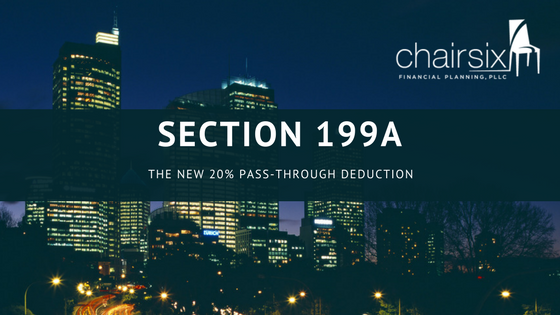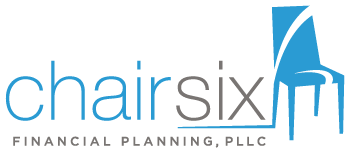
26 Jan Section 199A – The 20% Pass-Through Deduction
The Tax Cuts and Jobs Act of 2017 was signed into law by President Trump on December 22, 2017, and most of its provisions became effective January 1, 2018. The most interesting and impactful provision in the law is the new Section 199A deduction for certain pass-through business income. There is a lot of confusion surrounding this new provision, and I don’t believe anyone yet knows with certainty all the ramifications (we have no Treasury regulations or guidance to work with). However, while the 199A deduction is a bit complicated, the basics are straightforward.
The 199A deduction is equal to 20% of domestic “qualified business income” (QBI) from a pass-through entity. The deduction essentially produces an effective top marginal rate of 29.6% on QBI (37% X (1-20%)). If your marginal tax rate is 24%, your income tax rate on QBI will be 19.2% (24% X (1-20X)). This is a very powerful deduction that, when planned accordingly, can save a huge amount of federal income tax.
Who qualifies for the deduction? Eligible taxpayers include sole proprietorships (Schedule C), some owners of rental real estate (Schedule E), S-Corporation owners (Form 1120S) and Partnership owners, including LLCs taxed as partnerships (Form 1065). Basically, anyone with business income who is not an employee or a C-corp is eligible for the deduction. Since the corporation tax rate for C-corporations was reduced to a flat 21%, the 199A deduction is designed to create some parity between pass-throughs and C-Corporations.
Interestingly, the deduction also applies to estates and trusts, which is going to provide a lot of planning opportunities in estate planning.
However, there are some limitations, and, to apply those limitations, the first step is to determine the taxable income of the taxpayer. If taxable income is less than $315,000 for married taxpayers filing jointly ($157,500 for singles), the taxpayer is entitled to the full 20% deduction against QBI (or taxable income, whichever is lower). There really is no doubt about it. The limitations only affect higher income taxpayers. So, if you are a married taxpayer with $100,000 of qualified business income and another $100,000 of wage or other income, you will receive a $20,000 deduction (20% x $100K of QBI). If, however, a taxpayer’s taxable income is less than their QBI amount (due to other tax losses and deductions), the 20% deduction would be applied to taxable income rather than QBI.
This first threshold is huge, as taxpayers with taxable incomes below threshold do not have to apply any further limitations. The threshold amounts for eligible taxpayers (adjusted for inflation!) are:
| Single persons | $157,500 | |
| Married persons | $315,000 | |
| Estates | $157,500 | |
| Trusts | $157,500 | |
| Kids subject to “kidde” tax | $157,500 |
Small businesses came out big winners in the final law; they get the full deduction. Higher income earners, those above the taxable income threshold, will have to deal with further limitations. Accordingly, the next step in applying those limitations is to determine whether the business is a “specified service business” or a non-service business. This is an important distinction because, for a service business above the $315,000 threshold, the deduction is phased out, while for non-service businesses above the threshold, a limitation is phased in. Confusing? A little bit- let’s break it down.
Specified Service Business
A “specified service business” is defined in Section 1202(e)(3)(A) as “(a)any trade or business involving the performance of services in the fields of health, law, accounting, actuarial science, performing arts, consulting, athletics, financial services, brokerage services, or any trade or business where the principal asset of such trade or business is the reputation or skill of 1 or more of its employees.” Architects and engineers, which are included in the section 1202 rules, have been excluded from the specified services business definition- most likely because those professions were entitled to the old 199 domestic activities production (DPAD, or manufacturers’) deduction, while other service professionals were not.
So, this definition includes most professionals and businesses engaged in providing a service. What constitutes “consulting” and whether the service provided is impacted by the reputation or skill of 1 or more of its employees will cause some gray areas, and we will need more guidance. But, for the most part, if a business is selling a professional service, the business is probably a specified service business.
Any business that does not fit the definition of a specified service business, and the taxpayer’s taxable income is above the threshold amounts ($315,000 for MFJ), is subject to a W-2 wage or W-2 wage plus capital test that may limit the taxpayer’s eligibility for the full 20% deduction. This test, or limitation, is phased in between taxable incomes of $315,000 and $415,000 for MFJ and 157,500 and 207,500 for singles. This limitation is a bit more straight-forward then the limitations imposed on specified service businesses, so let’s begin there.
199A Deduction for a Non-specified service businesses (i.e., traditional businesses and real estate trades or businesses)
When taxable income reaches $415,000, the deduction becomes the lesser of 1) 20% of QBI or 2) the greater of 50% of w-2 wages or 25% of w-2 wages plus 2.5% of the unadjusted basis (immediately after acquisition) of qualified depreciable property (no land). This limitation is phased in between $315,000 and $415,000 of taxable income.
The depreciable property must be in the “depreciable period” which begins on the date the property was first placed in service and ends on the later of 1) 10 years later or 2) the last day of the last full year in the applicable recovery period that would apply to the property under section 168. So, for, older property, the taxpayer might not have the ability apply the 2.5% test. Real estate purchased 40 years will have difficulty qualifying for a 199A deduction. However, if the taxpayer is below the threshold amount, the taxpayer doesn’t have to worry about the wage and capital tests – so managing the threshold is going to be critical.
For example, let’s say a taxpayer has taxable income of $1,500,000 and owns a manufacturing business taxed as an S-Corp that produces $1,000,000 of qualified business income. The business also pays w-2 wages of $300,000 and has $3,500,000 of depreciable property. The 199A deduction would be $162,500, which is the lower of the following amounts:
1. $200,000, which is 20% of qualified business income of $1,000,000
2. $162,500, which is the greater of 50% of w-2 wages ($150,000) or 25% of w-2 wages plus 2.5% of depreciable property ($75,000 + 87,500 = $162,500).
Proper entity selection will be important for taxpayers above the threshold range, as there will need to be W-2 wages and/or depreciable property in the depreciable period. A self-employed married taxpayer making $1,000,000 may not get a deduction if they are taxed as a disregarded entity, but if they elect to be taxed as an S-Corp, they could pay themselves a wage and then be eligible for a deduction. Tony Nitti at Forbes hits on this point here.
199A Deduction for Specified Service Businesses
When a taxpayer is above the taxable income threshold (again, $315,000 MFJ), and the taxpayer has qualified business income from a specified service business, determining the deduction is a bit more complicated. Not only is the wage or wage plus capital test being phased in, but the deduction is also being phased-out! No deduction is available when taxable income is $415,000 or above. The phase-out formula for QBI for married filing jointly is as follows:
For example, say a taxpayer has taxable income of $365,000 and QBI from a specified service business of $200,000. Their potential deduction would not be $40,000 (20% X $200,000), but instead, only be $20,000, because 50% of the deduction has been phased out (when applying the above formula).
But remember, a wage or wage and capital test is also being phased in, and the the amounts used for these potential limitations are being phased out as well. For example, a taxpayer who is 50% into the threshold range would only use 25% of wages or 12.5% wages and 1.25% of depreciable property to figure out their 199A, while at the same time this limitation is being phased in. It’s complicated stuff.
Again, the phase-out range for married filing jointly is between $315,000 and $415,000 and for singles is between $157,500 and $207,500. Once taxable income reaches the top of these ranges, NO DEDUCTION IS AVALIABLE for qualified business income from a specified service business.
Summary
if taxable income is below the $315,000 threshold, all taxpayers with pass-through business income are eligible for the deduction. Above the threshold- up to $415,000 of taxable income, specified service businesses will have their deduction phased out while a W-2 wage or wage plus capital limitation is phased in, while non-service businesses will have a W-2 wage or w-2 wage and capital limitation phased in. When taxable income exceeds $415,000, specified service businesses lose the deduction completely, while non-service businesses are subjected to the W-2 and capital limitations.
Since the deduction is taken at the personal level and subject to individual phase-outs/phase-ins, the results for individual taxpayers involved in the same business may be very different.
The deduction is taken after computing adjusted gross income, and there is no Alternative Minimum Tax (AMT) adjustment. The deduction is limited to income tax, and it sunsets for taxable years beginning after December 31, 2025.
There appear to be a few options to managing the limitations imposed by section 199A. If a taxpayer has taxable income above the threshold amount, then reducing taxable income will increase the 199A deduction. Using a defined benefit plan or making charitable contributions will reduce taxable income and may increase the 199A deduction.
When a taxpayer has excess limitation, that is, when the limitation exceeds 20% of QBI, then decreasing wages may make sense. For example, if a business has 200,000 of QBI and $100,000 of w-2 wages, the 199A deduction would be $40,000 (20% of $200,000). The business could decrease w-2 wages to $90,000, which would increase QBI to $210,000 and receive a 199A deduction of $45,000 (which is equal to both 20% of 210,000 and 50% of w-2 wages of $90,000).
Also, spinning out non-specified service business activities from a specified service business may create opportunities to increase the 199A deduction. Some taxpayers may benefit from putting their service business into a C-Corp while their rental income is in a passthrough entity in order to keep the taxpayer below the threshold amounts to be eligible for the full 20% deduction on the rental income.
A lot of innovative planning is going to be centered around Section 199A. There are a lot of moving pieces, and it’s a very dynamic area. This isn’t meant to be a complete analysis, and I expect much more to be written in the coming months/years. Each taxpayer will need to evaluate their individual situation to decide how best to proceed. It’s all very exciting!
UPDATE: This post was modified for clarity on February 18, 2018.
________________________________________________________________________________________
Originally Posted January 26th, 2018



Sorry, the comment form is closed at this time.